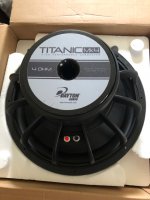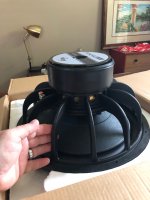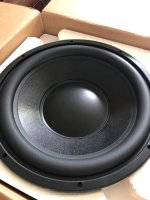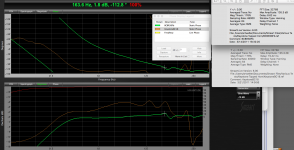It seems that an increased width does increase the efficiency at 40hz and 100hz, but does NOT increase efficiency in the valley. This leads to a more lumpy response. This can be corrected using eq, but then what is the point of the increased efficiency if it is only being corrected for.
Perhaps the lumpiness will even out with increased mouth size or with more subs placed closely together, however I haven't yet modelled that.
Perhaps the lumpiness will even out with increased mouth size or with more subs placed closely together, however I haven't yet modelled that.
Art,
I have a trouble to find an enclosure for AE TD18H with effective range of 35-110hz because of the cabinet size limitation. It could be tall but can't be deeper then 65cm/27 inches. Your Keystone seems to fit)))
I'm wonder if the cone MMS 165gr will survive in Keystone pressure (home use)?
Thank you.
Fs: 29Hz
Qms: 5.9
Vas: 390 L
Cms: .19 mm/N
Mms: 165 g
Rms: 5.03 kg/S
Xmax: 14 mm(peak)
Xmech: 25 mm(peak)
Sd: 1218 sqcm
Vd: 3.42L (p-p)
Qes: .23
Re: 5.6 ohm
Le: .41 mH
Z: 8 ohm
Bl: 27.06 T/m
Pe: 1000W (cont.)
Qts: .22
1WSPL: 98.15 dB
2.83V: 99.7 dB
I have a trouble to find an enclosure for AE TD18H with effective range of 35-110hz because of the cabinet size limitation. It could be tall but can't be deeper then 65cm/27 inches. Your Keystone seems to fit)))
I'm wonder if the cone MMS 165gr will survive in Keystone pressure (home use)?
Thank you.
Fs: 29Hz
Qms: 5.9
Vas: 390 L
Cms: .19 mm/N
Mms: 165 g
Rms: 5.03 kg/S
Xmax: 14 mm(peak)
Xmech: 25 mm(peak)
Sd: 1218 sqcm
Vd: 3.42L (p-p)
Qes: .23
Re: 5.6 ohm
Le: .41 mH
Z: 8 ohm
Bl: 27.06 T/m
Pe: 1000W (cont.)
Qts: .22
1WSPL: 98.15 dB
2.83V: 99.7 dB
Grec,Art,
I'm wonder if the cone MMS 165gr will survive in Keystone pressure (home use)?
"Home use" doesn't have a universal meaning for sound pressure level (SPL).
At levels around 122 dB, one watt one meter, half space (way more than eviction levels in my home) the light cone would have no survival issues, pushed another 6dB harder, it may. It probably would give some audible signs of distress before any permanent deformation would occur.
Art
Hi Art,
wonderful thread, been following for a while now..
Just drafting up the CAD work at the moment to see how things fit..
May i ask, is there any benefit in increasing the compression stage at the beginning of the horn, Be it a piece of wood across the entry hole on the baffle?
I just have a gut instinct with keeping the compression high and steering the entry point all the way to the very beginning of the horn? Probably a silly experiment....
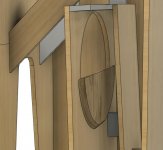
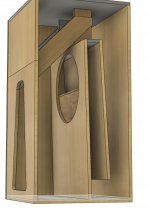
Also got my hands on 4 18SW115s, are you able to attach the 3d file so i can work with it..
Thanks
Dec
wonderful thread, been following for a while now..
Just drafting up the CAD work at the moment to see how things fit..
May i ask, is there any benefit in increasing the compression stage at the beginning of the horn, Be it a piece of wood across the entry hole on the baffle?
I just have a gut instinct with keeping the compression high and steering the entry point all the way to the very beginning of the horn? Probably a silly experiment....


Also got my hands on 4 18SW115s, are you able to attach the 3d file so i can work with it..
Thanks
Dec
Last edited:
1) Does not look beneficial to me, but no harm in trying an A/B test.1)May i ask, is there any benefit in increasing the compression stage at the beginning of the horn, Be it a piece of wood across the entry hole on the baffle?
2)Also got my hands on 4 18SW115s, are you able to attach the 3d file so i can work with it..
2) I don't have any 3d files.
Update on my two Keystones ... they are doing really well! I have the B&C drivers to make two more, but haven't purchased the wood yet. Some upgrades:
- Added 4x 3" casters on the back using 1" lag screws
- Added black metal corners from parts express. The front mouth plate gets two tabbed corners at the bottom.
- Added 4x 2" rubber feet on the bottom of each cab
- Added 4x 2" rubber feet on the long side, each cab symmetrical so they can sit longways on the ground, mouths together.
- added some extra bracing to the front mouth plate, as I found it would vibrate/resonate when I'm pushing it hard (can only really hear >3-5' away) - used some 2" square pages with a slight angle on the baffle side and square on the mouth plate side (anchored with Gorilla glue & some Kreg jig screws).
Right now I'm running them from 28 BW 48 - 60 Hz LR 24, then the kick bins 70 LR 24 - 150 LR 12, then the mid-tops 160 LR 12 - 15k BW 24
Using SMAART and my Driverack, the Keystones are not delayed, but I'm needing >10ms of delay to the kick bins, and around 10ms to the tops. Overall, 20ms delay is no problem for playing music, but for a DJ even with a booth speaker the lag is noticeable. I run the KS full range to get an impulse lock, or can just phase align Keysones and mid tops to the kick bins. Either way, I'm getting some cancellations around 60, 80 near the pass band overlap. I tried a polarity inversion but cannot seem to get the traces to have the same slope. The LR phase for 2nd order is 90 degrees so should be able to get it in with <10ms of delay for the pass band.
Question #1: Anyone have luck mixing the Keysones with direct radiated kick bins, and phase aligning them? I am thinking that I may try either a BW or Bessel filter for less phase shift and eq out the bump. I just need good phase overlap between a tapped horn and a direct radiated dual 15" GSub.
Question #2: I've noticed some "port chuffing" when running these two at war volume with my Crown MA3600VZ (each speaker is 8 ohm, so getting around 3,000w into 4 ohms parallel, 1,500w per speaker) - the chuff comes from right near the speaker and I'm pretty close to XMax if not over. Bringing down the level slightly makes the chuff vanish. And it's only at certain frequencies (40-50 Hz seems like) - is there anything I can do to reduce the chuff? I thought for a second my speaker was not sealing correctly but it's not that, I have 8 Allen bolts into T-nuts all torqued the same.
See pic below!

- Added 4x 3" casters on the back using 1" lag screws
- Added black metal corners from parts express. The front mouth plate gets two tabbed corners at the bottom.
- Added 4x 2" rubber feet on the bottom of each cab
- Added 4x 2" rubber feet on the long side, each cab symmetrical so they can sit longways on the ground, mouths together.
- added some extra bracing to the front mouth plate, as I found it would vibrate/resonate when I'm pushing it hard (can only really hear >3-5' away) - used some 2" square pages with a slight angle on the baffle side and square on the mouth plate side (anchored with Gorilla glue & some Kreg jig screws).
Right now I'm running them from 28 BW 48 - 60 Hz LR 24, then the kick bins 70 LR 24 - 150 LR 12, then the mid-tops 160 LR 12 - 15k BW 24
Using SMAART and my Driverack, the Keystones are not delayed, but I'm needing >10ms of delay to the kick bins, and around 10ms to the tops. Overall, 20ms delay is no problem for playing music, but for a DJ even with a booth speaker the lag is noticeable. I run the KS full range to get an impulse lock, or can just phase align Keysones and mid tops to the kick bins. Either way, I'm getting some cancellations around 60, 80 near the pass band overlap. I tried a polarity inversion but cannot seem to get the traces to have the same slope. The LR phase for 2nd order is 90 degrees so should be able to get it in with <10ms of delay for the pass band.
Question #1: Anyone have luck mixing the Keysones with direct radiated kick bins, and phase aligning them? I am thinking that I may try either a BW or Bessel filter for less phase shift and eq out the bump. I just need good phase overlap between a tapped horn and a direct radiated dual 15" GSub.
Question #2: I've noticed some "port chuffing" when running these two at war volume with my Crown MA3600VZ (each speaker is 8 ohm, so getting around 3,000w into 4 ohms parallel, 1,500w per speaker) - the chuff comes from right near the speaker and I'm pretty close to XMax if not over. Bringing down the level slightly makes the chuff vanish. And it's only at certain frequencies (40-50 Hz seems like) - is there anything I can do to reduce the chuff? I thought for a second my speaker was not sealing correctly but it's not that, I have 8 Allen bolts into T-nuts all torqued the same.
See pic below!

Last edited:
1) Your "direct radiated kick bins" appear to be ported- a "phase inversion" system. The output at Fb is delayed by one wave period, in addition to the crossover filter- you may find better alignment with little or no delay, or no port.Right now I'm running them from 28 BW 48 - 60 Hz LR 24, then the kick bins 70 LR 24 - 150 LR 12, then the mid-tops 160 LR 12 - 15k BW 24
Question #1: Anyone have luck mixing the Keysones with direct radiated kick bins, and phase aligning them? I am thinking that I may try either a BW or Bessel filter for less phase shift and eq out the bump. I just need good phase overlap between a tapped horn and a direct radiated dual 15" GSub.
Question #2: I've noticed some "port chuffing" when running these two at war volume with my Crown MA3600VZ (each speaker is 8 ohm, so getting around 3,000w into 4 ohms parallel, 1,500w per speaker) - the chuff comes from right near the speaker and I'm pretty close to XMax if not over. Bringing down the level slightly makes the chuff vanish. And it's only at certain frequencies (40-50 Hz seems like) - is there anything I can do to reduce the chuff? I
2) Maximum excursion and harmonic distortion for the Keystone is at 45Hz, above Xmax you may be hearing that as "chuff", if it bothers you then the only solution would be to limit that frequency range.
Art
1) Your "direct radiated kick bins" appear to be ported- a "phase inversion" system. The output at Fb is delayed by one wave period, in addition to the crossover filter- you may find better alignment with little or no delay, or no port.
2) Maximum excursion and harmonic distortion for the Keystone is at 45Hz, above Xmax you may be hearing that as "chuff", if it bothers you then the only solution would be to limit that frequency range.
Art
Hi Art, you're right I used the "wrong" term but I think where my head is at is because I'm using the ported dual 15" well above the resonant frequency (~1 octave?), the ports act just like a solid wall and don't allow any air through, so it effectively is a direct radiator from >80 Hz (Fb 40 Hz). You do make a good point I'm going to play around with a variety of filters this weekend using SMAART.
And good to know about the 45Hz, it's not really that audible with distance and only at war volume - as you say, I can eq it, compress/limit, etc.
One more question - I see in the thread that there was a "step-down" plate reducing the opening down to as little as 8 inches, offering extra low end extension and SPL at the expense of less useable high end. Since I'm not using the high end of the Keystones (XO ~ 70-80Hz), I think that the plate would serve but are there any other considerations other than screwing in (bolting on?) a cover plate? I'm also scratching my head as to how the extension is lower with a smaller opening, perhaps you can share your thoughts on this?
Thanks much! Really enjoying the design and learnings that come with DIY.
Hi Carl,Would the keystone work for the Dayton audio 15” titanic mk4 sub driver 4 ohms single coil. And if so. What’s the size of box or even better. A link to a cut sheet and build plans.
Thanks
The external dimensions are 45" tall, 26.5" wide, 22.5" deep.
You can find links to the plans in the original posts, as well as links to Hornresp simulations, which would allow you to input your driver's TS parameters and see how they compare to other drivers.
Art
1) The phase transition from bass reflex (BR) to "solid wall" is gradual, as you can see in the example below of a 38Fb BR compared to the Keystone TH. At 160 Hz, there is around 10.8ms time of flight difference between the two, but the phase difference varies by around 240 degrees over the passband from 38 Hz to 160 Hz.1)..I'm using the ported dual 15" well above the resonant frequency (~1 octave?), the ports act just like a solid wall and don't allow any air through, so it effectively is a direct radiator from >80 Hz (Fb 40 Hz). You do make a good point I'm going to play around with a variety of filters this weekend using SMAART.
2)I think that the plate would serve but are there any other considerations other than screwing in (bolting on?) a cover plate? I'm also scratching my head as to how the extension is lower with a smaller opening, perhaps you can share your thoughts on this?
2)Aesthetic, structural and tuning are about it on the list of considerations.
The answer to your "head scratcher" is probably along the continuum between "tapped horn", "transmission line" and BP6
Art
Attachments
Hey guys. New to the thread here, also fairly green to horns as well. I'm planning on building a few keystones with the 18TBW100. I noticed in the original post that this driver was tested at 1048 watts yet its rated for 1500. Can anyone explain to me why this might be? Can this driver be run at the full 1500 watts? I'm in the process of choosing the amp/amps and this will help me out.
Thanks, Sam
Thanks, Sam
Sam,
Above Xmax, voltage/power increases do not result in a linear increase in SPL, so the average was given without exceeding Xmax.
The OP figures you have referenced were Hornresp simulations at rated Xmax. The 18TBW100 can take 1500-3000 watt peaks, but would exceed Xmax at those levels, a simulation at those voltage levels won't reflect actual output.
The length of time the driver can withstand a "full 1500 watts" depends on the crest factor of the signal.
Art
Above Xmax, voltage/power increases do not result in a linear increase in SPL, so the average was given without exceeding Xmax.
The OP figures you have referenced were Hornresp simulations at rated Xmax. The 18TBW100 can take 1500-3000 watt peaks, but would exceed Xmax at those levels, a simulation at those voltage levels won't reflect actual output.
The length of time the driver can withstand a "full 1500 watts" depends on the crest factor of the signal.
Art
Understood, Thank you! On a similar note, I have a question regarding amps. At this point I plan on using the NX6000 which claims 3,000 watts/channel into 4 ohms or 1600 watts/channel into 8 ohms. I plan on running 4 keystones. Would it be worth it to use 2 NX6000's and use one channel per sub @ 8 ohms or could I get away with using 1 NX6000 and run 2 subs per channel @ 4 ohms?
Thanks, Sam
Thanks, Sam
If you have decided on using 8 ohm drivers, there would be little difference between using one or two per side of a NX6000.
That said, the 3 dB more power available using 4 ohm drivers would be my preference, but would require two amps. My preference would also be using a pair of NX4-6000, two channels bridged mono into each 4 ohm sub, if one amp were to fail all four subs could still be powered by the remaining amp.
That said, the 3 dB more power available using 4 ohm drivers would be my preference, but would require two amps. My preference would also be using a pair of NX4-6000, two channels bridged mono into each 4 ohm sub, if one amp were to fail all four subs could still be powered by the remaining amp.
- Home
- Loudspeakers
- Subwoofers
- Keystone Sub Using 18, 15, & 12 Inch Speakers
